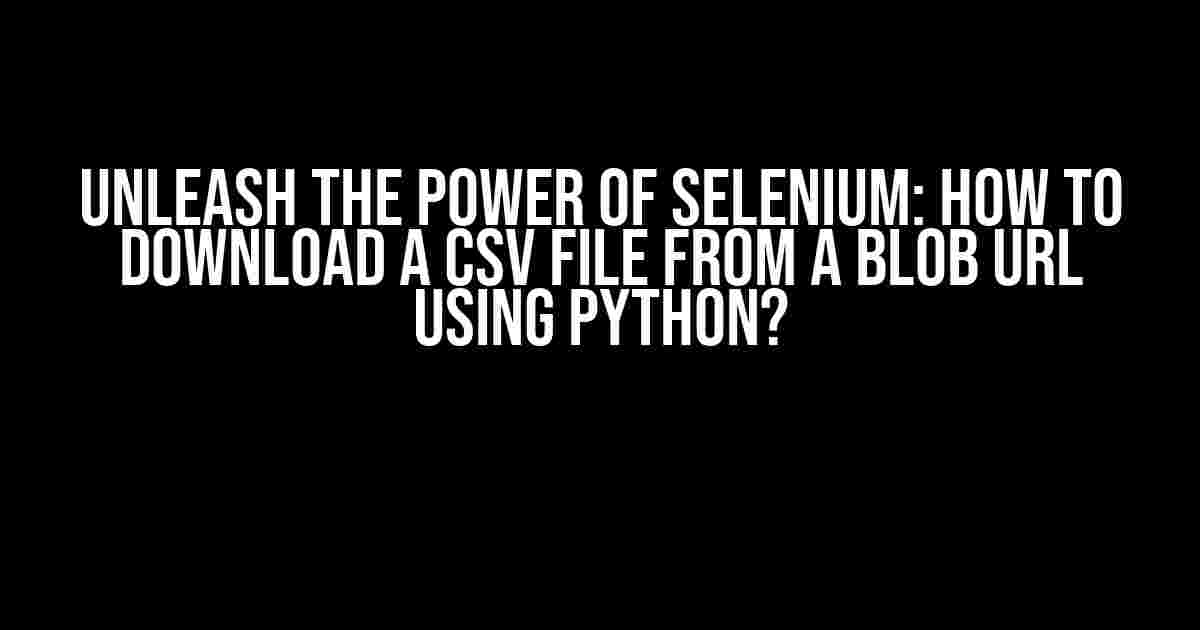- Introduction
- What is a Blob URL?
- Why Use Selenium?
- Setting Up Your Environment
- Step 1: Create a New Selenium WebDriver Instance
- Step 2: Navigate to the Blob URL
- Step 3: Authenticate and Wait for the File to Load
- Step 4: Get the File URL and Download the CSV File
- Step 5: Clean Up and Close the WebDriver
- Putting it All Together
- Conclusion
- Troubleshooting Tips
- Best Practices
- Final Thoughts
Introduction
Are you tired of manually downloading CSV files from blob URLs? Do you wish there was a way to automate this process using Python? Well, you’re in luck! In this article, we’ll explore how to download a CSV file from a blob URL using Selenium in Python. This powerful combination of tools will allow you to automate the process with ease, saving you time and increasing your productivity.
What is a Blob URL?
Before we dive into the tutorial, let’s quickly cover what a blob URL is. A blob URL is a URL that points to a file stored in a cloud storage system, such as Azure Blob Storage or Amazon S3. These URLs are typically used to serve files directly from the cloud, bypassing the need for a web server.
Why Use Selenium?
So, why do we need to use Selenium to download a CSV file from a blob URL? The reason is that blob URLs often require authentication or have restrictions in place to prevent direct downloads. Selenium, being a web automation tool, allows us to interact with the website as if we were a real user, circumventing these restrictions.
Setting Up Your Environment
Before we begin, make sure you have the following installed:
- Python 3.x
- Selenium WebDriver (WebDriver for Chrome or Firefox)
- Pandas library for CSV file manipulation
You can install the required libraries using pip:
pip install selenium pandasStep 1: Create a New Selenium WebDriver Instance
First, create a new instance of the Selenium WebDriver. We’ll use Chrome as our example, but you can use Firefox or any other browser of your choice:
from selenium import webdriver
# Create a new instance of the Chrome WebDriver
driver = webdriver.Chrome('/path/to/chromedriver')Step 2: Navigate to the Blob URL
Next, navigate to the blob URL using the `get` method:
# Navigate to the blob URL
driver.get('https://example.com/blob/url')Step 3: Authenticate and Wait for the File to Load
If the blob URL requires authentication, you’ll need to enter your credentials using Selenium. For the sake of simplicity, we’ll assume you’ve already authenticated and the file is loading.
Use the `WebDriverWait` class to wait for the file to load completely:
from selenium.webdriver.support.ui import WebDriverWait
from selenium.webdriver.support import expected_conditions as EC
# Wait for the file to load completely
WebDriverWait(driver, 10).until(EC.presence_of_element_located((By.TAG_NAME, 'body')))Step 4: Get the File URL and Download the CSV File
Now that the file has loaded, we can get the file URL using Selenium’s `execute_script` method:
# Get the file URL
file_url = driver.execute_script('return window.URL.createObjectURL(blob)')Next, use the `requests` library to download the CSV file:
import requests
# Download the CSV file
response = requests.get(file_url, stream=True)
# Get the file name from the response headers
file_name = response.headers.get('Content-Disposition').split('=')[1]
# Save the file to disk
with open(file_name, 'wb') as f:
for chunk in response.iter_content(1024):
f.write(chunk)Step 5: Clean Up and Close the WebDriver
Finally, clean up and close the WebDriver instance:
# Close the WebDriver instance
driver.quit()Putting it All Together
Here’s the complete code snippet:
from selenium import webdriver
from selenium.webdriver.support.ui import WebDriverWait
from selenium.webdriver.support import expected_conditions as EC
import requests
# Create a new instance of the Chrome WebDriver
driver = webdriver.Chrome('/path/to/chromedriver')
# Navigate to the blob URL
driver.get('https://example.com/blob/url')
# Wait for the file to load completely
WebDriverWait(driver, 10).until(EC.presence_of_element_located((By.TAG_NAME, 'body')))
# Get the file URL
file_url = driver.execute_script('return window.URL.createObjectURL(blob)')
# Download the CSV file
response = requests.get(file_url, stream=True)
# Get the file name from the response headers
file_name = response.headers.get('Content-Disposition').split('=')[1]
# Save the file to disk
with open(file_name, 'wb') as f:
for chunk in response.iter_content(1024):
f.write(chunk)
# Close the WebDriver instance
driver.quit()Conclusion
And that’s it! You’ve successfully downloaded a CSV file from a blob URL using Selenium in Python. This powerful combination of tools allows you to automate a wide range of web-based tasks, including downloading files from blob URLs.
By following the steps outlined in this article, you’ll be able to download CSV files from blob URLs with ease, saving you time and increasing your productivity.
Troubleshooting Tips
| Issue | Solution |
|---|---|
| File not downloading | Check that the blob URL is correct and that the file is loading completely. |
| Authentication issues | Make sure you’ve authenticated correctly and that the WebDriver instance is using the correct credentials. |
| File corruption | Check that the file is being saved correctly to disk and that there are no issues with the file size or format. |
By following these troubleshooting tips, you’ll be able to overcome common issues and successfully download CSV files from blob URLs using Selenium in Python.
Best Practices
- Use the correct WebDriver instance for your browser of choice.
- Make sure you’ve authenticated correctly and that the WebDriver instance is using the correct credentials.
- Use the `WebDriverWait` class to wait for the file to load completely.
- Use the `requests` library to download the CSV file.
- Save the file to disk using the correct file name and format.
By following these best practices, you’ll be able to ensure that your code runs smoothly and efficiently, allowing you to focus on more complex tasks.
Final Thoughts
Downloading CSV files from blob URLs using Selenium in Python is a powerful way to automate web-based tasks. By following the steps outlined in this article, you’ll be able to overcome common challenges and successfully download CSV files with ease.
Remember to troubleshoot common issues, follow best practices, and experiment with different scenarios to get the most out of Selenium and Python. Happy coding!
Frequently Asked Question
Getting stuck on downloading a CSV file from a blob URL using Selenium in Python? Worry not, we’ve got you covered!
Q1: Why do I need Selenium to download a CSV file from a blob URL?
You need Selenium because a blob URL is a virtual URL that doesn’t allow direct file downloads. Selenium allows you to automate a browser instance, which can handle the blob URL and facilitate the file download.
Q2: What are the prerequisites for downloading a CSV file using Selenium in Python?
You’ll need to have Python installed, along with the Selenium library and a WebDriver (like ChromeDriver or GeckoDriver) that matches your browser version. You’ll also need to import the necessary libraries and set up your WebDriver instance.
Q3: How do I use Selenium to navigate to the blob URL and initiate the download?
Use the WebDriver instance to navigate to the blob URL using the `get()` method. Then, use the `execute_script()` method to execute a JavaScript script that clicks the download link and initiates the file download.
Q4: How do I handle the file download dialog box that appears after initiating the download?
You can handle the file download dialog box by setting the browser preferences to automatically download files to a specific directory. This can be done by modifying the WebDriver instance’s options and preferences.
Q5: What’s an example code snippet that demonstrates downloading a CSV file from a blob URL using Selenium in Python?
Here’s an example code snippet:
“`python
from selenium import webdriver
# Set up the WebDriver instance
options = webdriver.ChromeOptions()
options.add_experimental_option(‘prefs’, {‘download.default_directory’: ‘/path/to/download/folder’})
driver = webdriver.Chrome(options=options)
# Navigate to the blob URL
driver.get(‘https://example.com/blobURL’)
# Execute a JavaScript script to initiate the download
driver.execute_script(‘document.querySelector(“a.download-link”).click()’)
# Close the WebDriver instance
driver.quit()
“`
Note: Replace the `blobURL` with your actual blob URL and `/path/to/download/folder` with your desired download directory.



